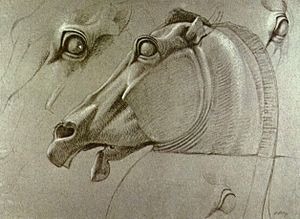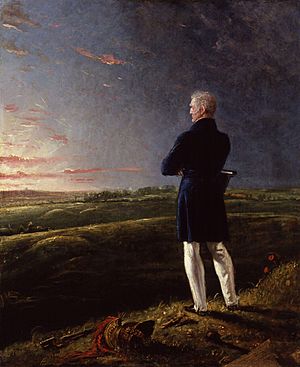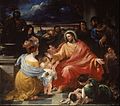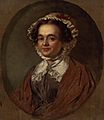Benjamin Haydon facts for kids
Quick facts for kids
Benjamin Robert Haydon
|
|
|---|---|

Self-portrait, c.1845. National Portrait Gallery, London.
|
|
| Born |
Benjamin Robert Haydon
26 January 1786 Plymouth, England
|
| Died | 22 June 1846 (aged 60) |
| Occupation | Painter |
| Children | 3 |
Benjamin Robert Haydon (born 26 January 1786 – died 22 June 1846) was a British painter. He was best known for his large historical paintings, which often showed important moments from the past. He also painted some pictures of everyday life and portraits of people.
Haydon faced many money problems throughout his life. This was partly because he often had disagreements with the people who paid for his art. Also, he liked to paint very big pictures, which cost a lot to make. He even spent time in a special prison for people who couldn't pay their debts. After he died, his detailed diaries were published, giving us a look into his life and thoughts. He also gave many talks about art.
Contents
Early Life and Art Journey
Childhood and Early Dreams
Benjamin Robert Haydon was born in Plymouth, England. His father was a successful printer and publisher, and his mother encouraged his love for learning. From a young age, Benjamin showed a strong interest in studying. He went to Plymouth Grammar School and later Plympton Grammar School, where another famous painter, Joshua Reynolds, had also studied. Reading books about anatomy (the study of the body) made him want to become a painter.
Starting at the Royal Academy
In 1804, full of excitement, Haydon moved to London to study at the Royal Academy Schools. He was so dedicated that one of his teachers, Henry Fuseli, asked him when he found time to eat!
In 1807, at just 21 years old, Haydon showed his first painting at the Royal Academy. It was called The Repose in Egypt and was bought by a wealthy collector named Thomas Hope. This was a great start! He soon got another important job from Lord Mulgrave and met Sir George Beaumont, another art supporter.
In 1809, he finished his painting Dentatus. This painting made him more famous, but it also started a long argument with the Royal Academy. They hung his large painting in a small side room instead of the main hall, which upset him. That same year, he took on his first student, Charles Lock Eastlake, who later became a very important person in British art.
Money Troubles Begin
Haydon's money problems started in 1810. His father stopped giving him an allowance because Benjamin was starting to have some success. He also had disagreements with Sir George Beaumont and Richard Payne Knight. Knight didn't think the Elgin Marbles (ancient Greek sculptures from the Parthenon) were valuable. Haydon, however, loved the Elgin Marbles. He believed they showed how ancient Greek artists studied the human body, which was very important to him.
His next painting, The Judgment of Solomon, sold for £700. He also received £100 from the British Institution and was honored by his hometown of Plymouth. But even with this money, he still had debts. He kept borrowing money to support his art.
Peak of His Career
Important Paintings and Personal Life

In 1814, after the fighting with France ended, Haydon visited Paris with his friend David Wilkie. He saw the art collections that Napoleon had gathered at the Louvre museum. He was surprised that some famous paintings, like Raphael's Transfiguration, seemed "small & insignificant" to him. In Paris, he also saw a portrait of Napoleon and became fascinated by the defeated French leader.
When he returned to England, he painted Christ's Entry into Jerusalem. This painting later became a main part of the American Gallery of Painting in Philadelphia. While working on another big painting, Resurrection of Lazarus, his money problems grew. He was briefly arrested but not put in prison.
In October 1821, he married Mary Hyman, a widow with two young children. This added to his responsibilities. In 1823, Haydon spent two months in a special prison for people who couldn't pay their debts. While there, he wrote a request to Parliament. He asked them to create a committee to support historical painting in Britain. This request was presented by Lord Brougham.

More Artworks and Challenges
In 1825, Haydon tried painting portraits to earn money, and at first, he did well. However, a harsh review in a newspaper called John Bull hurt his reputation. Haydon believed this article caused him to lose customers and fall deeper into debt.
After another time in prison in 1827, he painted The Mock Election. This painting was inspired by a funny event he saw in prison. King George IV bought it for £500! Encouraged by this, Haydon painted a companion picture, Chairing the Member, even going back to the prison to draw some of the people there. He also painted a scene of a Punch and Judy show. He hoped the king would buy this one too, but he was disappointed.
Some of Haydon's other paintings include: Eucles (1829), Napoleon at St Helena (for Sir Robert Peel), Xenophon, on his Retreat with the 'Ten Thousand,' first seeing the Sea, and Waiting for the Times (all 1831). He also painted Falstaff and Achilles playing the Lyre (1832), and Curtius Leaping into the Gulf and Uriel and Satan (1843).
As a supporter of parliamentary reform (changes to the government), he wanted to paint a huge picture of a meeting led by Thomas Attwood. But he couldn't raise enough money, so only sketches were made. However, he did get a job from the prime minister, Lord Grey, to paint the Reform Banquet. This painting, finished in 1834, included 597 individual portraits! He also painted the Meeting of the Anti-Slavery Society, which is now in the National Portrait Gallery.
Later Years and Legacy
Haydon became well-known for his talks about painting. From 1835, he traveled all over England and Scotland, giving lectures. He strongly believed that public buildings should be decorated with history paintings that showed important moments from Britain's past. After the Palace of Westminster burned down in 1834, he immediately visited the prime minister to explain how important it was for the government to support art, especially for the rebuilding.
Even though a plan similar to his ideas was used for the Houses of Parliament, Haydon was not chosen to be part of it. In 1843, an exhibition was held to choose designs for the new paintings. Haydon submitted two of his own designs, but the committee (which included his former student, Eastlake) didn't choose either of them.
He then painted The Banishment of Aristides and showed it at the Egyptian Hall in Piccadilly, where he had rented a gallery many times before. At the same time, a famous American dwarf, General Tom Thumb, was also performing there. During Easter week, 12,000 people paid to see Tom Thumb, but only 133 people visited Haydon's art exhibition. This was a big disappointment for him.
Death
Benjamin Haydon died on 22 June 1846. He was buried in St Mary's Church, Paddington, London. His grave is still there today, though it is modest and worn.
Writings
In 1839, Haydon started writing his autobiography, using his many detailed diaries. He finished writing about his life up to the year 1820 before he died. This autobiography was published in 1853, along with more material from his diaries.
People who read his autobiography often notice how much he loved his art. He was very passionate about it. He found it hard to work with people who paid for his art, and sometimes he was very stubborn. He believed strongly in his own abilities and that art would eventually triumph. He saw himself as a champion for "high art" (important historical paintings) and felt he deserved support from the nation.
His autobiography also shows that Haydon often prayed. He believed in a kind and guiding power that influenced his life and family. Even though his strong and sometimes argumentative personality caused him problems, he always had high goals for his art.
Haydon also wrote articles and lectures about painting. He wrote a long and detailed article on "Painting" for the 7th edition of the Encyclopædia Britannica.
Critical Opinion
Not everyone thought Haydon was a great painter. Charles Dickens wrote in 1846 that Haydon "had utterly mistaken his vocation" and was "a very bad painter." Dickens felt that Haydon's pictures "could not be expected to sell or to succeed."
Students and Influence
Haydon taught several students who went on to become important artists themselves. These included Charles and Edwin Landseer, William Bewick, John Jackson, and Edward Chatfield.
Haydon's life and work have also appeared in other creative works:
- The poet William Wordsworth wrote a sonnet (a type of poem) called To B.R. Haydon in 1815.
- John Keats mentioned Haydon in several of his poems, including Addressed to Haydon and To Haydon with a Sonnet Written on Seeing the Elgin Marbles.
- In 1977, the actor Leonard Rossiter played Haydon in a play called The Immortal Haydon.
- In 2007, a new one-man play based on Haydon's life and diaries, called Blood, Bone and Genius, was performed at the Royal Academy Schools.
- In 2008, a play called Influence explored a meeting between John Keats and Haydon.
- In the 2014 film Mr. Turner, Haydon is played by Martin Savage.
Images for kids














